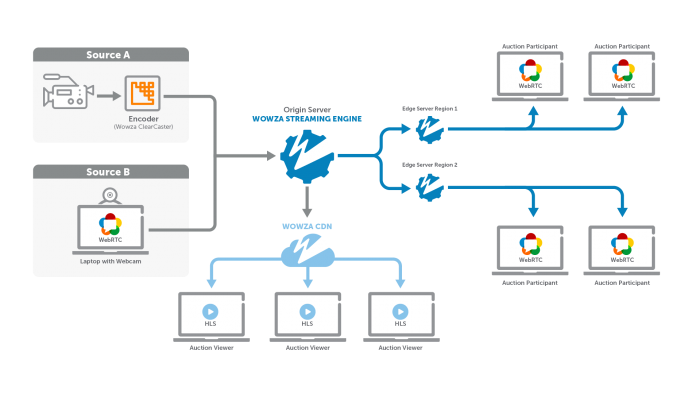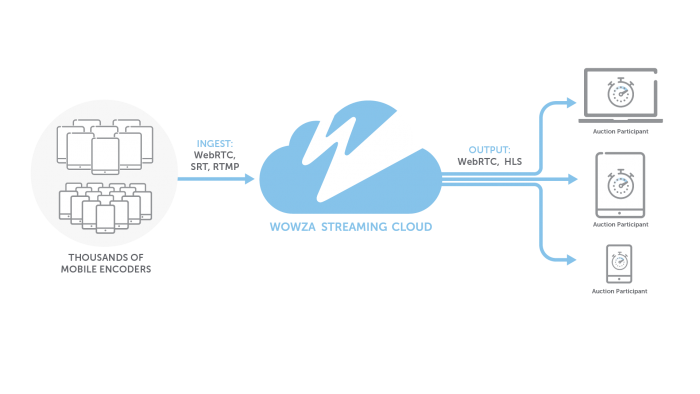Live Streaming Recommendations for Successful Online Auctions

Live streamed auctions have steadily increased in recent years, but 2020 has undeniably catalyzed the digitalization of live bidding. This past summer, the famed auction house Sotheby’s conducted its first live fine-art auction. Bidders everywhere, from New York to Hong Kong, accessed the auction in London via a live stream to vie for artworks from the art world’s biggest names. Sotheby’s was testing the waters, but when that one event generated $192.7 million dollars, online auctions proved to be a success.
The digitalization of live bidding isn’t limited to traditional auction houses either. There’s been a surge of live commerce apps that have incorporated live bidding into their platforms. Apps such as Taobao, China’s biggest online shopping destination, have fused online retail with live streaming. Taobao’s influencers on the site ascend to celebrity-like status, helping elevate the shopping experience from mundane to swanky. And in the same way that they would at a Nordstrom beauty counter, consumers can ask questions and learn product application techniques.
The takeaway? Online auctions are here to stay. And streaming them successfully requires different capabilities for each use case mentioned above.
We put together this guide, which breaks down the anatomy of a good streaming solution and the requirements needed to improve online auctions for each live bidding use case.
Online Auction Houses
From fine art auctions in London to livestock auctions in Oklahoma, more and more kinds of live auctions are moving online. Auction houses are combining real-time interactivity, community participation, and the closest possible experience to “being there” to recreate an atmosphere that entices customer participation. In order to do so successfully, any online auction house must take the following into account.
The First Mile Is Crucial
Auction live streaming, the first mile remains the least reliable part of their video streaming workflow. Because dropping frames or losing connections can result in frustrated bidders and lost sales, a successful auction requires that you have a quality source, reliable internet, and good connectivity.
You’ve heard the saying “You get what you put in,” right? It applies to video streaming too. It’s nearly impossible for encoders to reproduce missing information within a frame. Although most will do their best to smooth out the video, don’t expect the encoder to work miracles if your source is suboptimal.
Reliable internet and good connectivity are also imperative for a successful auction. Take, for instance, rural auctions of livestock with online auctioning. From a rural location, access to the internet can be difficult and more unreliable. Choosing a solution that brings the best-quality live video over the most unpredictable networks is critical. Certain protocols can be used for packet loss, as well as jitter and fluctuating bandwidth, to help the integrity and quality of your stream.

Near Real-Time Bidding on Any Device
Latency means everything to auctions. Auctions move very fast, and buyers need the ability to place bids in real time so that they don’t miss out. The more easily and quickly a potential bidder can access and view an auction item, the more likely that bidder will be to place a bid. It’s a win-win situation—and one that requires near real-time latency protocols such as WebRTC, Low-Latency HLS, or SRT. WebRTC is recommended if you require sub-one-second latency. As the fastest protocol on the market, WebRTC eliminates problematic delays and ensures that everyone has the same opportunity to place bets in near real time.
Get the free guide to low-latency streaming.
Download FreeOne-to-Many Streaming
One of the major benefits of streaming your auction is the ability to expose a world of online bidders to your events. Because of this, your platform has to have the ability to scale your viewership size while maintaining the quality of your stream. Capabilities such as autoscaling allow you to stream to any size audience, anywhere in the world, and without the hassle of managing it yourself. So, when thousands—or hundreds of thousands—of buyers log in to see or bid on exclusive, one-of-a-kind items, the network won’t get bogged down.
Another way to maximize your reach is through simulcasting. Enhancing the ability for widespread online attendance, simulcasting allows auctioneers to stream to any number of alternate platforms at the same time—further increasing bidder participation rates.
Online Marketplaces + Live Bidding
Live bidding on online marketplaces requires its own set of critical capabilities. Some capabilities overlap with online auction houses at a high level, but they’re used in different ways.
Near Real-Time Latency for Interactivity
As is the case with online auction houses, consumer-driven auctions through online marketplaces also have a need for real-time live video. But these types of use cases focus on interactivity instead. Buyers have the ability to chat with sellers, asking questions and making comments in real time. They can ask how the product feels or if it comes in different colors, and the sellers can answer directly, just as if they were in an actual store. To do this, marketplaces rely on low-latency technology to support unique streaming environments. Seamlessly synchronized and timed metadata, chat functionality, and two-way live video all are requirements for supporting a more authentic shopping experience.

Scalable Infrastructure
Typically online marketplaces are streaming to small and medium-sized audiences. So, although you might not need to scale your live stream to millions of viewers, you do still need the ability to scale your infrastructure. That’s because most marketplace platforms have a large number of sellers who could be streaming to small audiences at any given time.
Because sellers can spin up a live stream at any moment, the infrastructure also needs to be built to support dynamic live content. It’s less about scheduled events, such as traditional online auctions, and more about live streaming on the fly.
In this use case, you would dedicate a transcoder / live stream configuration to each user. When the user logs into the app’s UI and starts a new live auction, the app makes an API call to our Wowza Streaming Cloud Service, and we start up a new instance just for that user’s auction. Stacking can also be implemented so that multiple streams can be running on each transcoder to better control costs. This provides online marketplaces with the ability to start new instances on demand.
Mobile-Friendliness
Mobile is king, especially outside of the United States. People of younger generations only carry mobile phones, and they don’t own personal computers, so designing mobile first for a marketplace app is crucial. The platform needs to be designed for phones, but it has to be compatible with all devices. In order for “sellers” to send high-quality streams from their mobile devices, a streaming service or server (such as Wowza Streaming Cloud or Wowza Streaming EngineTM) needs to convert its content into multiple lower-quality levels and various formats. Adaptive bitrate streaming (ABR) is used to ensure that all viewers get the best stream that their individual network conditions and viewing devices allow at any time.
Summary
You should be able to find the right workflow and features that are specifically tailored for your live-bidding use case and needs. These are all recommendations. And although these major capabilities should help you run your online auction more successfully, you’ll most likely need other capabilities to build an end-to-end solution. The best thing to do is to use these suggestions as your starting point and then build your architecture around them.
Wowza is a professional live streaming platform that can help you bring your auctions online. Why not try our 30-day free trial? Discover how Wowza can improve your video live streaming to ensure that your online auctions are successful.




